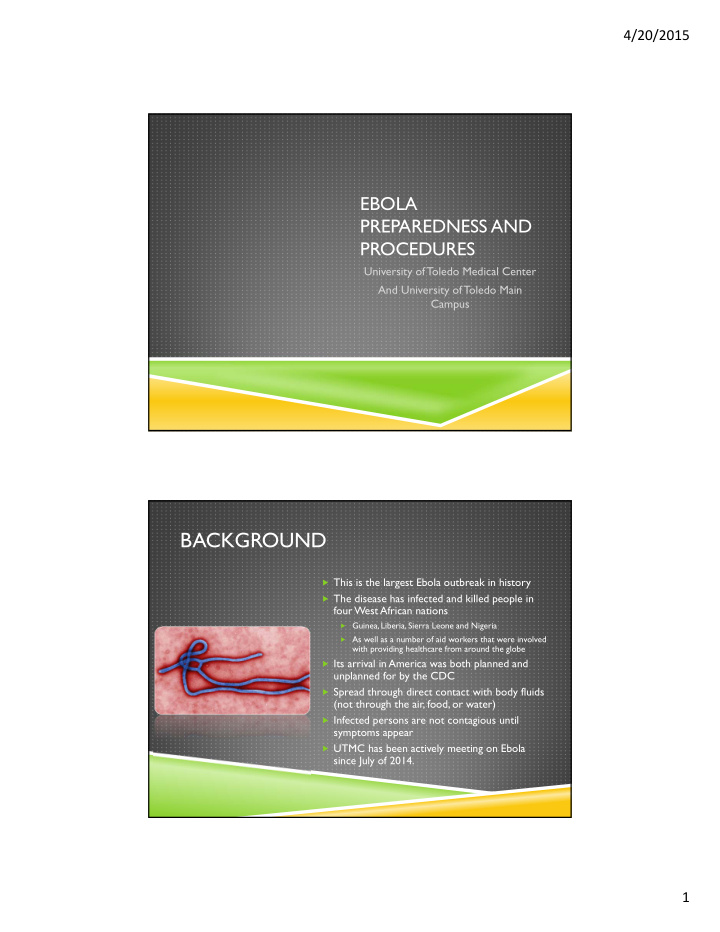



4/20/2015 EBOLA PREPAREDNESS AND PROCEDURES University of Toledo Medical Center And University of Toledo Main Campus BACKGROUND This is the largest Ebola outbreak in history The disease has infected and killed people in four West African nations Guinea, Liberia, Sierra Leone and Nigeria As well as a number of aid workers that were involved with providing healthcare from around the globe Its arrival in America was both planned and unplanned for by the CDC Spread through direct contact with body fluids (not through the air, food, or water) Infected persons are not contagious until symptoms appear UTMC has been actively meeting on Ebola since July of 2014. 1
4/20/2015 INITIAL SCREENING IN LATE JULY International students were screened via questionnaire The screening revealed no students returning from endemic areas and having contact with EVD patients TRAVEL REGISTRY Student, faculty and staff travelling outside of the U.S. are currently being asked to complete and online travel registry http://www.utoledo.edu/cisp/alerts.html In addition the Transportation Security Administration (TSA) is also updating local health authorities regarding travel to endemic areas. ODH has implement a “strengthened quarantine” strategy Web Page for Ebola http://www.utoledo.edu/depts/infectioncontr ol/CurrentHotTopics.html 2
4/20/2015 SCREENING IN THE ED AND CLINICS CODE ORANGE Upon notification of EVD patient, a Code Orange will be called Code orange procedures will be followed (w/Ebola additions) Triage personnel will put PPE (located in triage room) on themselves and the patient. Patient must remain in the triage room until relocation. Holding of patient takes place in Room #21 of ED for ~48hours Long term holding will be on 6CD 3
4/20/2015 SO WHO HAS BEEN TRAINED AND WHY? The ED staff nurse and doctors have been trained a number of times on PPE procedures in Simulation Center ED residents and others have also been trained but will not care for a confirmed EVD patient. We have a core team of ED docs and nurses that will care for the patient in the short term in the ED Attending faculty and nurses (mainly the ED) have volunteered to care for patients that may be held for an extended period on 6CD. Volunteers will continually be accepted and training will continue for this core group on a on-going basis. We have plans to extend our response if a more aggressive outbreak occurs in the region. Drills and simulations have been conducted and will continue to be performed to test our response capabilities. CHANGES TO PPE BASED ON CDC AND OTHER GUIDANCE Addition of blue booties These are placed on after Tyvek suit Attach strap to prevent bootie from slipping down Addition of pull over hood 4
4/20/2015 CHANGES TO N-95 KITS Addition of unattached hood The Tyvek’s attached hood must now be rolled and tucked into suit Unattached hood is placed over head and shoulders and tied in back Yellow gown goes overtop shroud of hood When removing hood, grasps top of hood, pulling upward and away from face 5
4/20/2015 OPTION OF PAPR GEAR The option of PAPR gear has been added It will be used with a blue outer gown It has a hood with built in face shield Used during prolonged periods in patient room N-95 PPE kits are still primary option when potential EVD patient presents as they are staged in triage 6
4/20/2015 7
4/20/2015 Emergency Department Zones and barriers Room 1300 will be • the hot zone for the patient Putting on PPE will • occur in 1261 Taking off PPE will • occur in 1260, removing all PPE Crocs will be • removed in 1262, and scrubs removed in 1261 Movement of Patient from ed 1300 to 6cd Patient • movement starts in 1300 Patient travels • to patient elevators following red dotted line 8
4/20/2015 Movement of Patient from ed 1300 to 6cd (Cont) Patient moves • from elevator to 6190 or 6186 if multiple patients 6cd Zones and barriers 6190 and/or 6186 • will be patient rooms Putting on PPE will • occur in 6182 Taking off PPE will • occur on red half of 6183 Crocs and scrubs • will be removed in 6183D 9
Recommend
More recommend